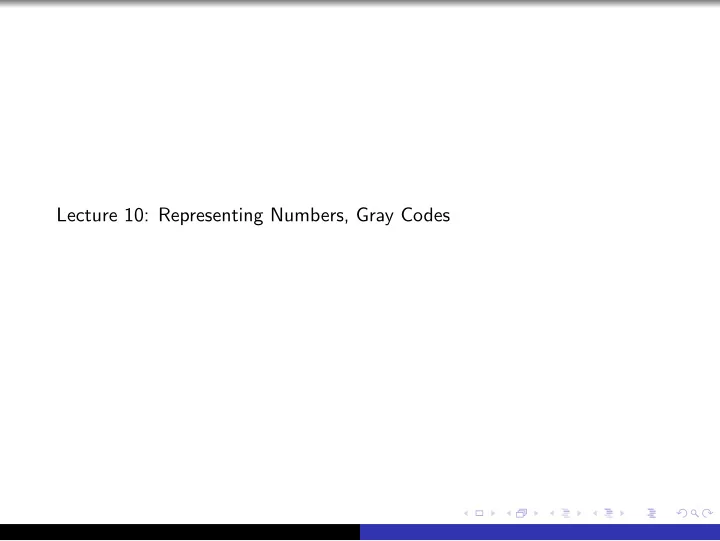

Lecture 10: Representing Numbers, Gray Codes
Base Basics For a base b , the highest value of any digit is b − 1 Computer scientists often use non-decimal bases binary 2 → Storing flags in a byte: 01100101 octal 8 → Unix permission bits: 0755 hexadecimal 16 → RGB color codes: #FF751A Hexadecimal uses 0–9 and A–F, where A = 10 and F = 16
Base Basics For a base b , the highest value of any digit is b − 1 Computer scientists often use non-decimal bases binary 2 → Storing flags in a byte: 01100101 octal 8 → Unix permission bits: 0755 hexadecimal 16 → RGB color codes: #FF751A Hexadecimal uses 0–9 and A–F, where A = 10 and F = 16 Question: Why might we favor these particular bases in computing?
Polynomial Expansions In decimal, we can represent: 10 different numbers using one digit: (0–9) 100 different numbers with two digits: (00–99) 1000 different numbers with three digits: (000–999) 10 n unique numbers with n ≥ 1 digits To understand why, consider the polynomial expansion of 1993 (1 × 10 3 ) + (9 × 10 2 ) + (9 × 10 1 ) + (3 × 10 0 ) .
Polynomial Expansions Using Powers of 2 We can do the same polynomial expansions using other powers. 22 = 10110 in binary 2 (1 × 2 4 ) + (0 × 2 3 ) + (1 × 2 2 ) + (1 × 2 1 ) + (0 × 2 0 ) 23 = 10111 in binary 2 (1 × 2 4 ) + (0 × 2 3 ) + (1 × 2 2 ) + (1 × 2 1 ) + (1 × 2 0 )
Polynomial Expansions Using Powers of 2 We can do the same polynomial expansions using other powers. 22 = 10110 in binary 2 (1 × 2 4 ) + (0 × 2 3 ) + (1 × 2 2 ) + (1 × 2 1 ) + (0 × 2 0 ) 23 = 10111 in binary 2 (1 × 2 4 ) + (0 × 2 3 ) + (1 × 2 2 ) + (1 × 2 1 ) + (1 × 2 0 ) Insight: A number is odd if and only if the last binary bit is a 1
Converting to Binary Checking for even/odd values tells us the last bit of a number’s binary representation Task: Implement the function num to binary(num) , which takes a number and returns its binary representation as a list of bits. Hint: What happens if we divide a number by 2 using integer division?
Converting to Binary 1 def num to binary(num): 2 ””” 3 return the binary representation of num as a list of bits (i.e., the integers 0 and 1) 4 ””” 5 if num == 0: 6 return [0] 7 8 bits = [] 9 while num > 0: 10 if num % 2 == 0: 11 bits.append(0) 12 else : 13 bits.append(1) 14 num = num // 2 15 bits.reverse() 16 return bits
Generalized Conversion How would we generalize this function to other bases? Hint: for any base b , the largest value of any digit is b − 1
Generalized Conversion 1 def num to baseb(num, b) : 2 ””” 3 return the b − ary representation of num as a list of base − b integers 4 ””” 5 if num == 0 : 6 return [0] 7 8 digits = [] 9 while num > 0: 10 digits.append(num % b) 11 num = num // b 12 digits.reverse() 13 return digits
Generalized Conversion 1 def num to baseb(num, b) : 2 ””” 3 return the b − ary representation of num as a list of base − b integers 4 ””” 5 if num == 0 : 6 return [0] 7 8 digits = [] 9 while num > 0: 10 digits.append(num % b) 11 num = num // b 12 digits.reverse() 13 return digits This function works well, but it uses the minimum number of digits possible. What if we wanted a consistent width to our numbers?
Fixed Width Binary Lists 1 def num to padded base(num, b, width) : 2 digits = [] 3 while num > 0: 4 digits.append(num % b) 5 num = num // b 6 7 digits.extend([0] ∗ (width − len (digits))) 8 digits.reverse() 9 return digits This also simplifies our code, since we don’t have to check for 0!
Printing Fixed Width Binary Lists 1 import sys 2 from math import log, ceil 3 4 n = int (sys.argv[1]) 5 b = int (sys.argv[2]) 6 width = ceil(log(n − 1, b)) 7 for i in range (n): 8 print (num to padded base(i, b, width))
Printing Fixed Width Binary Lists 1 import sys 2 from math import log, ceil 3 4 n = int (sys.argv[1]) 5 b = int (sys.argv[2]) 6 width = ceil(log(n − 1, b)) 7 for i in range (n): 8 print (num to padded base(i, b, width)) $ python3 printbinary.py 8 2 [0, 0, 0] [0, 0, 1] [0, 1, 0] [0, 1, 1] [1, 0, 0] [1, 0, 1] [1, 1, 0] [1, 1, 1]
Recommend
More recommend